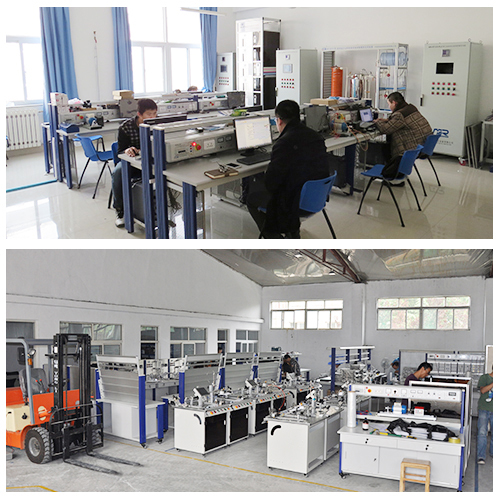MRB3714E5 Refrigeration And Air Conditioning Trainer With Reverse Cycle Educational Laboratory Equipment Refrigeration Trainer
1. Equipment Introduction
1.1 Overview
In today's technical training field, the cultivation of practical skills is essential. In response to this demand, the MRB3714E5 reverse cycle refrigeration and air conditioning training station came into being. It is an advanced equipment designed for education and professional training. This training station provides a platform that simulates a real industrial environment, enabling learners to deeply understand the operating mechanism of the reverse cycle refrigeration system and master the relevant operation and maintenance skills.
The design of the MRB3714E5 training station takes into account the integrity and practicality of teaching. It includes air-cooled fully enclosed compressors to forced air evaporators, condensers and a series of necessary measurement and control components to ensure that students can experience every link from the refrigerant cycle, heat exchange process to system control and fault diagnosis.
1.2 Features
Comprehensive learning platform: The core of the design of the MRB3714E5 training station is to provide a highly comprehensive learning platform. It integrates key components in the refrigeration and air-conditioning system, including air-cooled fully enclosed compressors, forced air evaporators and condensers, etc. These components work together to show students a real refrigeration cycle system. Through this integrated design, students can learn the workflow of the entire system on one device, so as to better understand the functions and interactions of each component.
Education-oriented design: The design of the equipment fully considers the teaching needs, and is equipped with a detailed experimental manual and instructions for use, so that students can deepen their understanding through practical operation. The transparent dust cover not only protects the equipment from dust, but also allows students to clearly observe the internal structure of the equipment, which increases the intuitiveness of teaching. This design enables students to learn in practice and consolidate theoretical knowledge through hands-on operation.
Safety first: Safety was put first when designing the MRB3714E5 training bench. The equipment is equipped with safety features such as emergency stop button, leakage protection and overload protection to ensure the safety of students when performing experimental operations. In addition, all electrical components and wiring meet international safety standards, providing students with a safe and reliable learning environment.
Practicality and durability: The practicality of the equipment is reflected in its mobility and durability design. The bottom is equipped with lockable casters, which is convenient for moving between different classrooms or training sites, and can be locked when in use to ensure stability. The workbench is made of high-strength plastic and stainless steel, which is durable and easy to clean, suitable for long-term teaching use.
Real-time data monitoring and analysis: In order to improve students' experimental analysis ability, the MRB3714E5 training station is equipped with instruments such as voltmeters, ammeters and digital temperature indicators. These instruments can display the working status of the system in real time, allowing students to monitor and analyze system performance and deepen their understanding of the operation of the refrigeration system.
Environmental protection concept: The R134A refrigerant used in the training station is an environmentally friendly refrigerant, which enables students to understand and apply current environmental regulations in practice and cultivate their awareness of environmental protection.
The MRB3714E5 reverse cycle refrigeration and air conditioning training station is a highly integrated, safe and user-friendly teaching equipment. It provides students with an ideal learning platform so that they can deeply understand all aspects of refrigeration and air-conditioning technology in practice. Through this practical operation, students can not only consolidate theoretical knowledge, but also improve practical operation skills, laying a solid foundation for their future career.
2. Technical parameters

Input power: AC 220V
Weight: <300kg
Working conditions: Temperature: 10℃~+40℃ Relative humidity: <85% (25℃)
Dimensions: 1700mm*750mm*1950mm
3. Component list and detailed introduction
3.1 Main part
No Name
1 Reverse cycle system
2 Electrical control module
3 Fault setting module
4 Workbench
3.2 Electrical control module
No Name
1 Power switch
2 Voltmeter
3 Amperemeter
4 Multi-channel temperature display instrument
5 Load switch
6 Compressor start/stop switch
7 Four-way reversing valve switch
8 Radiator fan switch
9 Condenser fan speed adjustment
10 Evaporator fan speed adjustment
11 Dual-channel pressure indicator
3.3 Fault Setting Module
The left side of the fault setting module is the electrical simulation diagram of the device with measurement points. Press the fault setting button on the right to set the fault. The faults are shown in the following figure and table.
No Name
F1 Motor two-phase cut-off fault button
F2 Condenser fan fault button
F3 Evaporator fan fault button
F4 Heavy hammer driver fault button
F5 Motor thermal protection fault button
F6 Condenser fan controller fault button
F7 Evaporator fan controller fault button
F8 Low pressure switch fault button
F9 High pressure switch fault button
F10 Four-way reversing valve fault button
LED Control Fault light hide button
Reset Fault reset button

Voltage Voltage measurement module button
Continuous Resistance Resistance measurement mode button
4. Experiment List
Experiment 1 Motor Two Phases Cut-off Fault Experiment
Experiment 2 Condenser Fan Fault Button
Experiment 3 Evaporator Fan Fault Button
Experiment 4 Heavy Hammer Driver Fault Button
Experiment 5 Motor Thermal Protection Fault Button
Experiment 6 Condenser Fan Controller Fault Button
Experiment 7 Evaporator Fan Controller Fault Button
Experiment 8 Low Pressure Switch Fault Button
Experiment 9 High Pressure Switch Fault Button
Experiment 10 Four-Way Reversing Valve Fault Button

